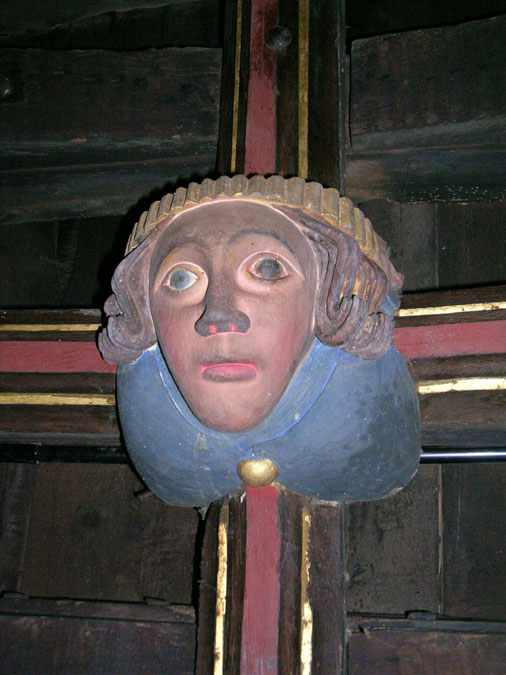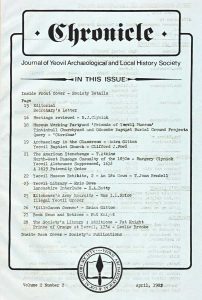This article came from the Chronicle
Volume 2(2) published April 1982. Page 22
Yeovil Museum Exhibits, 2 An 18c Gown
Author: T.Joan Rendell
The second item to be described from, the Yeovil Museum costume collection is a dress, dated about 1765-1775. The description of this gown needs to be recorded because it is too torn and fragile to be placed on display; but, because of its beauty and interest, merits being more widely known as part of the collection. The dress is a sack-back gown complete with petticoat and stomacher to match, the material a beautiful dark green. As with all textiles before the middle of the nineteenth century, only vegetable dyes could be used, aniline dyes not yet having been invented. In dyeing green, a rather difficult colour to obtain, two separate processes, were used. First, it was dyed blue (usually indigo), then, a second time, with yellow, probably Buckthorn, which gives a deep olive green – the colour of this particular dress. This gown has been washed, probably towards the end of its life, and it is interesting how the two colours have separated out. The blue has run in streaks, both on the garment itself and on the once-white lining, leaving a yellowish ground showing through, thus giving the, impression that the yellow was dyed first.
The full length of the back seam is sixty inches, and the width of the skirt is 110 inches. The back of the dress is intricately pleated and falls straight down into a small train. The fullness in the skirt is controlled at the side seams by six one-inch pleats grouped in threes, each side of the pocket hole. A pair of separate pockets was usually hung round the waist on a band, or string, with gaps in the side seams of the dress so ones hands could slide in to reach the pockets. The seam joining bodice to skirt is in the front, only.
The sleeves are elbow-length, fourteen inches from the top of the shoulder. There are two semi-circular frills at the back of the sleeve, the inner one nine inches in length, and the outer one seven inches. It narrows to two inches across the front of the sleeve and is trimmed by a small row of self material. Ruffles of lawn or lace would have been worn inside, as, at this period, white was always interposed between colours and flesh. The sleeve is weighted at the elbow beneath the frill, with a small semi-circular lead weight sewn into the hem. The stomacher is attached to the left side of the bodice and hooked up on the right. There is one black worked eye and two black hooks, though these are not original. It is trimmed with a self frill two inches wide and a bow at the neck. All the frills are pinked with scalloped edges. The dress is trimmed with a gathered scalloped frill, graduated in size from one-and-a-half inches at the neck down to eight inches wide at the hem. Elaborately scalloped pinking was the usual way of finishing edges on trimmings as it was flat, comparatively simple to do, and did not fray.
The whole dress is lined, which is not usual, and is probably part of the repairs. The bodice is lined in heavy linen, but the skirt of the dress and the petticoat are lined with a soft thin silky muslin, similar to India ,muslin, but a little more transparent.
The full petticoat is thirty-six inches long and 110 inches round the hem. The waist is plated with one-inch pleats starting at the centre front and facing towards the back. At the waist the folds are turned inside about two inches and the folded edge taped with a strong narrow green ribbon ending with heavy brown linen tapes to tie at the back. The petticoat has a twelve-inch wide frill at the bottom of the skirt, both edges of the frill being pinked with scallops. The two-and-a-half inch heading is folded over, whipped and pulled -up and then opened flat again with the seam looking like two joined pieces of material.
The dress has been repaired a number of times. The lining of the skirt has already been mentioned, but a more interesting repair is seen in the lining of the bodice where, at the centre back, a three-garter inch linen tape has been let in to widen the bodice a little. This was not done well, as the sides have not been replaced accurately, one side being a garter of an inch above the other side. The pleating at the centre back was not properly replaced and not even attached to the bodice. The original frill round the neck has been pulled out and stitched back flat without gathering from the top of the stomacher to the back of the neck.
This lovely gown has been in use a long time. It is comparatively plain for the period, and probably belonged to the same lady during the time it was in use. She may have been an upper servant or yeoman’s wife, as it is well cut and certainly elegant, but has seen much hard wear.
The important thing about this dress is that it is practically unaltered from its original shape and we can learn much from this detailed study of its construction. Gowns made in more elaborate styles and materials, such as brocades and figured satins, were more likely to be cut up and used again and altered extensively.
REFERENCES: (1) Nancy Bradfield :’Costume in Detail’. (2) Violetta Thurston : ‘Use of Vegetable Dyes for Beginners’. (3) Willett Cummington :’English Woman’s Clothing in the Nineteenth Century’. (4) ‘Costume Through the Ages’ : Ed. James Laver.

